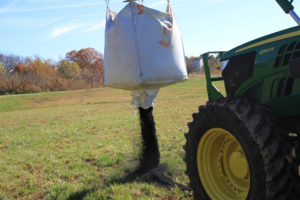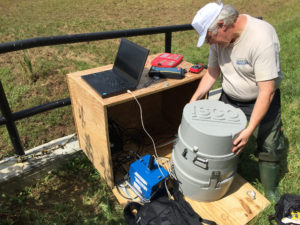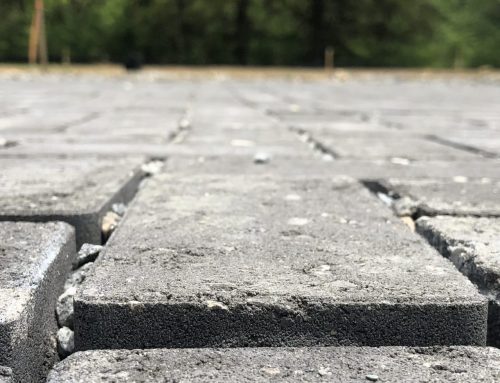With the 2025 deadline for reaching water quality goals in the Chesapeake Bay fast approaching, and the estimated price tag of $7.3 billion to meet these goals in Maryland alone, new, cost-effective strategies for reducing stormwater pollution are sorely needed. The Center for Watershed Protection led a three-year project to research the capability of “performance enhancing devices” or PEDs to boost the performance of standard stormwater best management practices (BMPs) for removal of specific pollutants. This work was funded through a grant from the National Fish and Wildlife Foundation and included the in-kind support of Carroll County, Maryland.
This project identified a variety of PEDs that can be incorporated into bioretention, sand filters, and other stormwater BMPs to increase nitrogen and phosphorus removal. Common PEDs include adding media amendments, incorporating an internal water storage zone in the underdrain system, and maximizing plant uptake. One of the first major tasks of this project was an extensive literature review and synthesis completed by the Center and its partner the Chesapeake Stormwater Network (CSN). This synthesis, Performance Enhancing Devices for Stormwater Best Management Practices: Final Report summarizes the findings of the literature review and recommends options for potentially adapting existing Chesapeake Bay nutrient reduction protocols to offer additional credits for stormwater BMPs that rely on one or more PEDs.
 One of the more promising PEDs identified in the literature review was the addition of biochar to stormwater BMP filter media. Biochar is a type of charcoal that is produced by the thermal decomposition of biomass such as wood chips and poultry litter at elevated temperatures. The second major component of this project was a two-year monitoring study to evaluate the ability of biochar to boost nutrient removal. Four BMPs were monitored, including sand filters and bioretention with and without biochar additives. Following an approved monitoring plan and QAPP, the study evaluated the ability of biochar to provide measurable and statistically valid water quality benefits compared to similar BMPs without biochar additives.
One of the more promising PEDs identified in the literature review was the addition of biochar to stormwater BMP filter media. Biochar is a type of charcoal that is produced by the thermal decomposition of biomass such as wood chips and poultry litter at elevated temperatures. The second major component of this project was a two-year monitoring study to evaluate the ability of biochar to boost nutrient removal. Four BMPs were monitored, including sand filters and bioretention with and without biochar additives. Following an approved monitoring plan and QAPP, the study evaluated the ability of biochar to provide measurable and statistically valid water quality benefits compared to similar BMPs without biochar additives.
The results indicated no significant impact on phosphorus removal due to the biochar additions; however, both types of systems exhibited substantial runoff volume reduction. These results can be partially explained by the very low inflow concentrations of phosphorus observed in this study. Available research suggests that BMP pollutant removal at sites with very low inflow concentrations are likely limited due to the “irreducible concentrations” in stormwater BMP outflows. Therefore, biochar may exhibit greater nutrient load reduction capacity when used in situations with higher load inputs.
The findings of both the literature review and the monitoring study have implications for stormwater professionals in the Chesapeake Bay  watershed and beyond. In 2018, the Center published a technical report Bioretention System Design Specifications and “Performance Enhancing Devices” to provide support for these professionals implementing PEDs in bioretention, in particular, related to the development of specifications for enhanced bioretention designs and media mixes. The report covers the evolving state design standards, fundamentals of nutrient adsorption in soils, and field studies of PEDs and informs the development of bioretention designs for specific pollutants of concern.
watershed and beyond. In 2018, the Center published a technical report Bioretention System Design Specifications and “Performance Enhancing Devices” to provide support for these professionals implementing PEDs in bioretention, in particular, related to the development of specifications for enhanced bioretention designs and media mixes. The report covers the evolving state design standards, fundamentals of nutrient adsorption in soils, and field studies of PEDs and informs the development of bioretention designs for specific pollutants of concern.
The project also included a webcast series on Performance Enhancements to BMPs which featured presentations from Tom Schueler (CSN), Dave Hirschman (Hirschman Water & Environment), Dr. Ryan Winston (Ohio State University), Dr. Allen Davis (University of Maryland), Stu Klausner (Cornell University ret.) and Center staff.
For more information about this project, contact Bryan Seipp, at bts@cwp.org.






